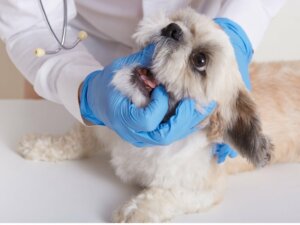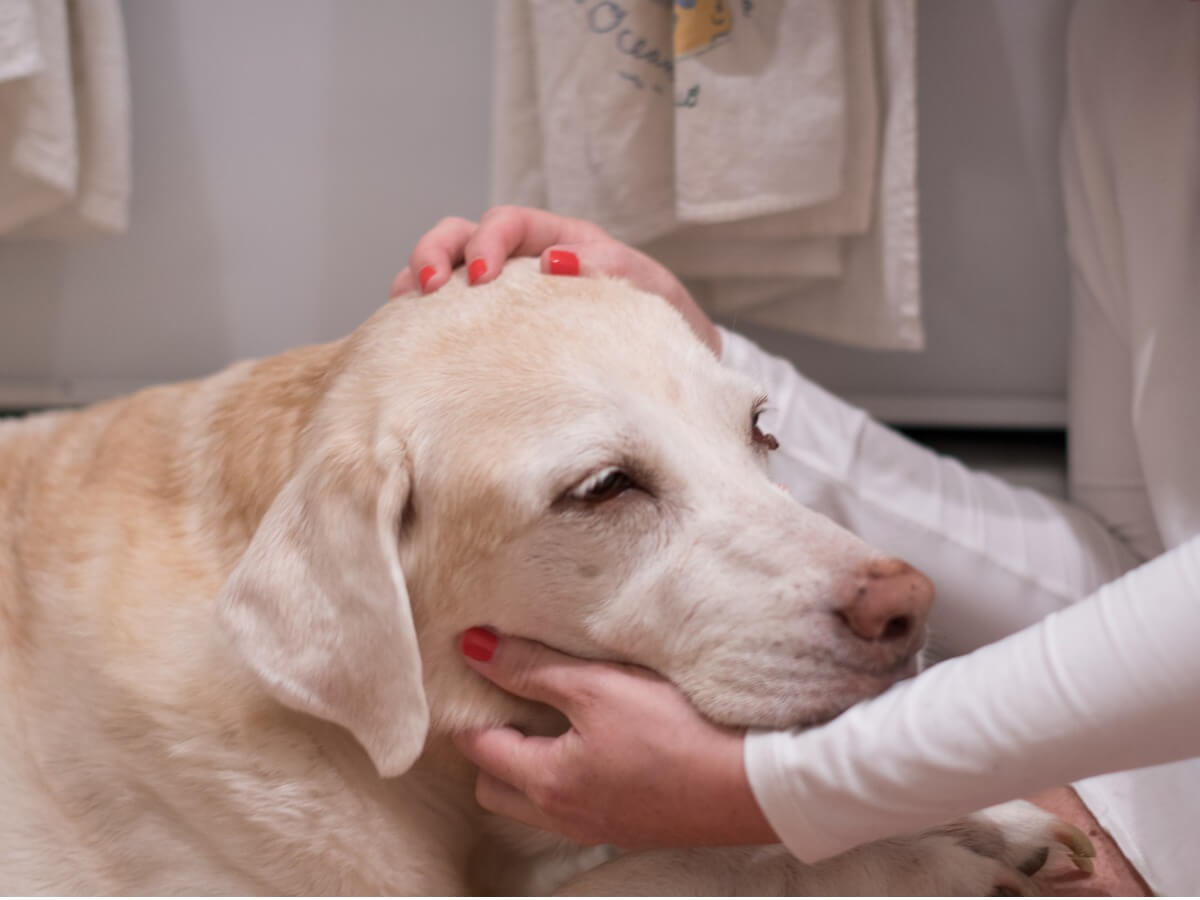Laryngitis in Dogs


Written and verified by the biologist Cesar Paul Gonzalez Gonzalez
The larynx is an organ in the respiratory tract that lies between the trachea and pharynx. This structure is responsible for protecting the airways, but also contains the vocal cords that produce the voice. In dogs, infections or the inhalation of an irritant can cause inflammation, leading to a condition known as laryngitis. Read on to learn more about laryngitis in dogs.
Barking is produced by the vocal cords in the dog’s larynx, and so an inflammation of this organ tends to cause loss of vocalization. In addition, if this condition isn’t properly controlled, it could begin to obstruct the animal’s airways.
What’s the larynx?
The larynx is a structure that acts as a valve and prevents the passage of foreign bodies into the airways. It also contains a series of cartilages that allow it to move or restructure according to the body’s needs. This change is also necessary to enable the dog to bark. For this reason, this organ has two main functions: the protection of the airways and vocalization.
The larynx is located between the pharynx and the trachea, where it’s responsible for blocking everything that isn’t air from entering the lungs. For this reason, this organ works more like a valve to prevent any obstruction in the airways.

What is laryngitis in dogs?
Laryngitis is the term used to refer to the inflammation of the mucous membranes or cartilage of the larynx. The main problem with this illness is how it affects the respiratory tract, as the swelling prevents the dog from being able to breathe properly. In addition, because air is constantly entering and exiting, the region becomes even more irritated if you’re not careful.
What are the symptoms of laryngitis in dogs?
This condition usually has very obvious and recognizable symptoms for the owner, as laryngitis affects one of the most necessary and important areas of the dog’s body. Some of the clinical signs that can help to diagnose laryngitis are as follows:
- Loss or change in the tone of the bark: The movements of the larynx are responsible for producing the bark, so any inflammation in this area can prevent vocalization or tone change drastically.
- Coughing: As it’s involved in the air intake, the larynx is constantly irritated, and that’s why a dry cough will start to develop.
- Difficulty breathing: The airways become obstructed if the inflammation increases too much, making it difficult for dogs to breathe properly.
- Breathing noises: A slight obstruction of the airways means that the dog’s breathing will be accompanied by strange noises.
- Panting: Dogs may feel discomfort in their throat (as if they have something “stuck”), which will cause frequent panting in an attempt to feel better.
- Loss of appetite: This condition can also cause difficulty in passing food down the esophagus. As a result, the pet will eat less or avoid food altogether.
- Fever: This is caused when an infection produces laryngitis.
- Abundant nasal fluid: This condition is often accompanied by other pathologies such as distemper, so it’s possible to observe a very watery nasal discharge or a different color than normal.
- Lethargy: Continuous discomfort and poor feeding cause the pet to feel tired or without any energy.
- Purple mucous membranes: This is a sign of lack of oxygenation in severe inflammation of the larynx.
What causes laryngitis?
The causes of laryngitis are usually easy to treat in the short term. However, care must be taken to avoid complicating the situation, and so you’ll need to attend to the animal promptly. Some of the factors that can cause inflammation of the larynx include the following:
- Excessive or very effusive barking
- Inhalation of irritants (smoke, dust or irritant gas)
- Trauma (blows or pulling by the collar)
- Exposure to cold air
- Direct damage to the larynx (from trying to give pills to a sick dog or eating food that is too large)
- Ingestion of foreign objects
- Infection (virus or bacteria)
Although most of the time laryngitis is caused by external factors, occasionally it can be caused by a pre-existing pathology. They can, therefore, be a side effect of other diseases or even surgery. The most frequent triggers are the following:
- Allergies
- Tracheobronchitis
- Distemper
- Surgery (damage from intubation)
- Obesity (due to forced breathing)
- Paralysis of the larynx
- Upper respiratory tract infections (pharynx, mouth, or nose)
As if that weren’t enough, some breeds of dogs such as pugs (which are brachiocephalic) are more likely to have laryngitis. This is due to the shape of their skull, which obstructs the passage of air and makes breathing difficult. Consequently, constant irritation is caused if the dog breathes too fast.
How is laryngitis diagnosed?
A tentative diagnosis can be made on the basis of actual symptoms. However, to be certain, the veterinarian could perform an endoscopy to allow them to observe the dog’s larynx. In this way, laryngitis can be confirmed or ruled out. At this point, if the inflammation in this region completely obstructs breathing, it’s possible for the professional to perform an emergency intubation.
It’s important to note that the diagnosis is also focused on identifying the cause of the inflammation. This is achieved through the medical history and complementary analysis. However, the veterinarian will be in charge of ordering the tests that are relevant to each case.
Treatment of laryngitis in dogs
The treatment of laryngitis focuses on improving the dog’s breathing. This is achieved by means of anti-inflammatory drugs (corticosteroids), although, in the most severe cases, an immediate tracheotomy may be necessary. In addition, if the dog’s oxygenation is too low, oxygen therapy is often recommended.
Once the dog has recovered from the initial symptoms, the next step is to deal with the secondary illnesses that may be causing the laryngitis. According to a scientific article in the journal Bulgarian Journal of Veterinary Medicine, the most frequent causes of this condition are opportunistic bacterial infections. In most cases, treatment with antibiotics will be necessary.
Is laryngitis dangerous for my dog?
Laryngitis is usually mild and won’t cause fatalities by itself. However, this depends on the causative agent, as, in some cases, the danger lies in the secondary pathology. For example, the inflammation alone can’t cause the pet to suffocate, but, in conjunction with laryngeal paralysis, it can suffocate the animal.
As you can see, laryngitis is a common pathology that only requires certain care to avoid complications. This doesn’t mean that you shouldn’t go to a veterinarian, as professional evaluation is necessary. If not, you’ll put your pet at serious risk by not knowing the causes of the disease. Remember that a timely diagnosis can save your dog’s life.
All cited sources were thoroughly reviewed by our team to ensure their quality, reliability, currency, and validity. The bibliography of this article was considered reliable and of academic or scientific accuracy.
- Uzunova, K. I., & Koleva, K. A. (2005). Importance of microclimate, floor type and floor bedding for the incidence of catarrhal rhinitis and laryngitis in dogs. Bulgarian Journal of Veterinary Medicine, 8(2), 135-139.
- ITOH, T., NISHI, A., KUSHIMA, K., UCHIDA, K., CHAMBERS, J., & SHII, H. (2016). Obstructive Pyogranulomatous Laryngitis in A Dog Treated with Permanent Tracheostomy. Jpn J Vet Anesth Surg, 47(1), 1-5.
- Aravena, L. A., Rico, B., Flores, E., & Cattaneo, G. (2004). Laringe canina y humana: um estudio para establecer homologia. Arquivos de Ciências Veterinárias e Zoologia da UNIPAR, 7(2).
- Mateo, A. G., Silva, L. B., & Sánchez, H. L. (2016). Anatomía e histología de las articulaciones de la laringe canina. Un modelo experimental. Revista Argentina de Anatomía Online, 7(2), 64-69.
- Pérez, B., Gómez, M., Mieres, M., Galecio, J. S., Yefi, C., & Aburto, P. (2010). Tomografía computarizada de la laringe en perros mesocefálicos. Archivos de medicina veterinaria, 42(1), 91-99.
- Eguren Silva, J. M. (2019). Síndrome del perro braquicefálico: actualización en su fisiopatología, diagnóstico y tratamiento.
- Baschar, H. A. (2017) CAPÍTULO 4: Laringoscopía y faringoscopía en Aprea, A. y Giordano, A., (Eds) Manual de endoscopía veterinaria, 46. Universidad Nacional de La Plata.
This text is provided for informational purposes only and does not replace consultation with a professional. If in doubt, consult your specialist.